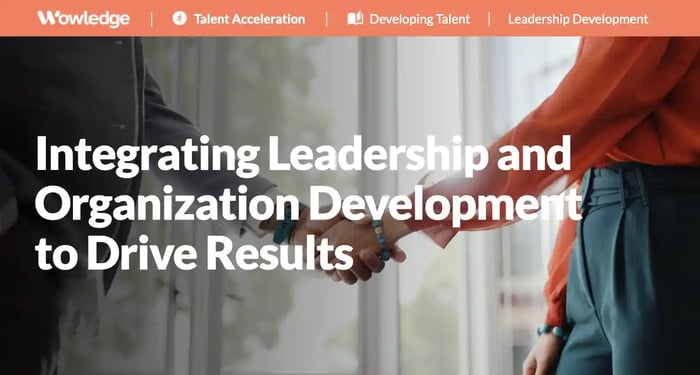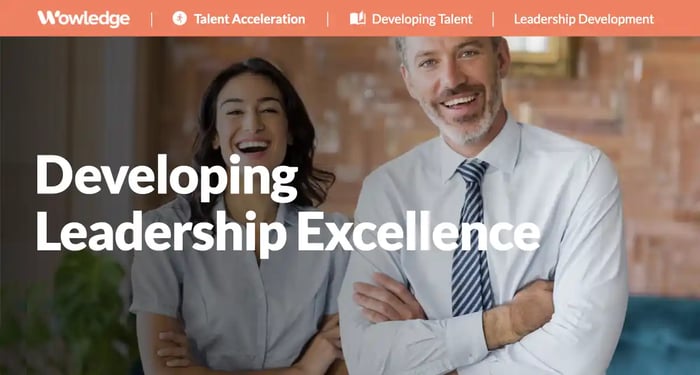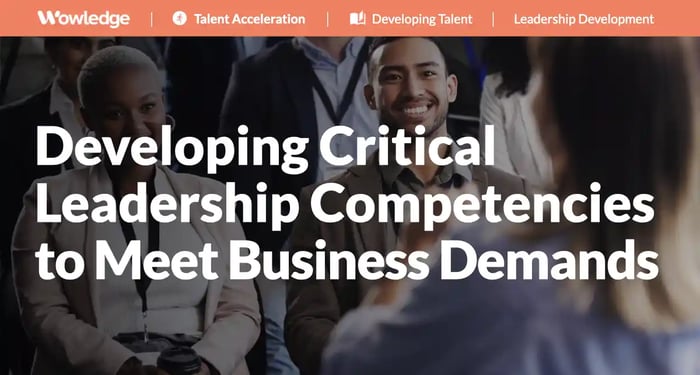Table of Contents
HR leaders often think about leadership effectiveness as a stand-alone concept in a vacuum. As a result, they miss out on it in the context of the larger organizational ecosystem and outcomes. The reasons for focusing on leadership effectiveness are to drive outcomes and create a culture that supports such outcomes. How organizations evolve leadership to support culture transformation frequently combines several traditional development approaches. To create true impact, a leader must focus on not just the strategies they devise but also the culture that supports the strategies and responds to the leadership that guides them towards their achievement. Integrating leadership and organization development approaches brings these together.
Bringing a broader, integrative approach to leadership development requires thinking about both the context in which leadership operates as well as the tools and methods that are used to bring about increased effectiveness. The context engages the broader organizational culture, and the methods involve a multi-dimensional approach beyond the singular use of coaching, consulting, mentoring, or facilitation.
Understanding how culture impacts results
Culture matters in organizations. As Gallup points out, “Culture is a force multiplier for the outcomes that matter most to you – and when properly harnessed, it becomes a powerful differentiator for your organization.” How an organization transforms its culture varies, as there are many levers to do so…leadership behaviors, practices, and systems, to name a few of the significant contributors.
McKinsey differentiates typical transformation from “transformative transformation”, which achieves “a well-managed balance between improving performance holistically and reinventing the business…measured along five dimensions that reflect organizational priorities."
The focus here is on three of those five dimensions:
1. Talent and Capabilities – evidenced through leadership behaviors.
2. Organizational Health – resulting from leadership practices.
3. Customer Focus – supported by leadership systems.
From experience, progress in the above three dimensions ultimately results in success for the other two dimensions:
4. Financial Performance.
5. Environmental, Social, and Governance (ESG) Impact.
In considering the distinction McKinsey makes about transformations, typical culture change efforts result in success only to a limited extent. Typical transformation efforts employ traditional approaches such as training to build leadership skills, individual coaching for executives, and/or teamwork facilitation. The challenge is that these often separate approaches, done at different times in the transformation process, require additional work to align the outcomes they create. Because this takes longer, it jeopardizes culture transformation efforts, which either bear little fruit or are unsustainable. By integrating leadership and organization development approaches, one can overcome these obstacles to success.

Key definitions
The focus of any leadership development process is to help people strengthen their impact. Understanding how those two key terms are defined in context is critical.
- Leadership in this context means taking responsibility in one’s world for whatever is happening and inspiring others to do the same. Being responsible includes being ‘response-able’ and adopting specific ways of being in action.
- Impact means leading purposefully, supporting others, and positively influencing outcomes to forge a legacy.
The essential focus needs to be on the impact of leadership in action more than the process of developing leadership skills, which is the traditional track of developing leadership competencies.
The ideal is to have the leadership development providers—typically HRBPs, coaches, and mentors—guide by operating as “Leadership Catalysts” in service of helping effect transformative culture change. Doing so helps organizations shift how they and their people operate and evolve into a “leadership system” that works collectively across their organization.
Acting in a “Leadership Catalyst” role requires a continual transition between five (5) formal roles that HR leaders typically leverage to develop and improve leadership performance. Those include:
Executive Coach
Partners with clients—individuals, teams, or groups—in a thought-provoking and creative process to inspire them to maximize their potential. When serving in this role, the key is to operate in an inquiry mode where the client executive sets the agenda and does most of the talking. Of all the possible leadership development roles, this is where the bulk of the integrated approach operates most, with the Catalyst using their business experience and acumen to inform questions and curiosity that strongly resonate with clients. This approach has been proven to create significant change over time.
Management Consultant
When not in inquiry mode, the Catalyst uses business and functional expertise to offer objective views on how the leader might improve performance to achieve organizational objectives. While much of this consulting is based on best practices, diagnostic organizational assessments and leadership culture surveys are best used to ensure appropriate client recommendations. Specifically, the most effective consulting expertise for this purpose includes:
- Employee engagement and retention
- Large-scale change leadership/management
- Leadership and management effectiveness
- Organization design / re-design
- Talent management and high-potential talent development
Strategic Advisor
Work with top executives and executive leadership teams to make the best choices to improve their future outcomes. This involves defining large-scale challenges or opportunities, asking relevant questions, and mining for deeper insights from people internally to affirm strategic decisions and direction. Such a role co-develops clients’ desired future state, goals aligned with their values, success measures supported through their organizational practices, and operating agreements with inherent accountability. During the process, the broad communication of plans and actions is encouraged while remaining open to change and reflecting on learning.
Trusted Mentor
Provides insight and support where the expertise matches leadership’s needs and aspirations. This role can be played informally or formally and involves active listening, guidance, and encouragement on our part.
Growth Facilitator
Facilitates organizational leadership growth by creating an environment conducive to learning and reflection, providing support and guidance, and fostering social interaction. This role can be played informally or formally. This can take shape when formally done through deep-dive education on subjects that support developing leadership potential. Sample topics include:
- Conversations for Impact
- Growing Your Career
- Leader as Coach
- Mental Fitness for Leadership
- The Value of Values
As the Catalyst performs these various formal roles, they must be clear about—and adhere to—the methods, responsibilities, and professional standards for each. For example, coaching is a confidential process that requires one to ethically and responsibly navigate the relationships involved. This can include the person being coached, the manager of the person being coached, the person’s HR Business Partner, and the sponsor who selected us to provide the coaching.
Furthermore, when switching between different formal roles with clients, transparency about the role being played at the moment is essential. For example, coaching is a client-driven process and thus is distinct from other roles, such as Consultant and Mentor, where expertise or experiential insights are offered.
Playing the “Leadership Catalyst” role to support clients’ bigger picture and create long-term impact for them supports integrating leadership and organization development, allowing coaches, consultants, and/or HRBPs to demonstrate and role-play their leadership capability through the service(s) provided.

The value delivered by a Leadership Catalyst
From a scientific—precisely chemical—standpoint, a “catalyst” increases or speeds up the rate of a chemical reaction. It does this by decreasing the activation energy, providing an alternative pathway of reduced activation energy. Said plainly, more can be achieved with less effort.
Regarding human behavior, a leadership catalyst helps create a new state of being for the organization through its leadership ability, which speeds up organizational transformation. The catalyst helps leaders shift how they operate to embrace a way of demonstrating that they are responsible for their world/work and inspiring others to do the same.
Others have explored this catalyst concept in the context of leadership and performance in organizations:
- Bill Joiner and Stephen Josephs used “catalyst leader” and “catalyst leadership” throughout their book "Leadership Agility". They describe the “Catalyst” as one of five leadership levels in their framework (i.e., Expert, Achiever, Catalyst, Co-Creator, and Synergist).
- The term “catalyst” is referenced through the VACC (Visionary, Architect, Catalyst, and Coach) leadership model by McKinsey & Company. In their 2019 article, McKinsey promotes the idea that "today's complex business environment calls for a new approach to leadership through the four “VACC” roles that broaden the stakeholders to whom they are responsible.
- In the practice of agile software development, a Scrum Master plays a catalyst-like role as an “Agile Coach” who estimates tasks in a system – either those that can be fit into a sprint (pushing work) or those only performed when work is available (pulling work).
In contrast to agile coaching, performing the “Leadership Catalyst” role is focused on helping people with how they work, not what they do as tasks.
The approach develops leaders holistically in three critical areas of their role, starting with the individual and expanding to their team and the entire organization.
The approach
The integrated approach employs a framework and proven path holistically spanning from individual to team to the entire organization. It is an organic approach to expanding leadership that starts with wherever a person, team, or organization is. It helps:
Strengthen the leader’s core…by exploring:
- values, strengths, and priorities to create CLARITY.
- desires, mindsets, and intentions to influence CHOICE.
- confidence, conviction, and practice to grow COURAGE.
Expand the leader’s influence…by practicing:
- openness, risk-taking, and presence to support ENGAGEMENT.
- curiosity, appreciation, and trust to foster CONNECTION.
- debate, collaboration, and innovation to generate GROWTH.
Transform the leader’s horizons…by creating:
- insight, alignment, and declaration to energize VISION.
- support, involvement, and synergy to shape COMMUNITY.
- inspiration, commitment, and action to initiate MOVEMENT.
How to operate in a Leadership Catalyst capacity
To understand how to perform as a “Leadership Catalyst,” three case scenarios (based on real examples of everyday client needs) will be instructive and illustrative. They are depicted through the three paths. In these scenarios, while the clients may request a specific “formal” role (e.g., Coach, Consultant, Facilitator), with the use of data and insights from diagnostic organizational assessments, the value of ‘flexing’ the roles demonstrates how the HR professional, by integrating leadership and organization development approaches can act we to help clients best achieve their desired outcomes.
Case 1 – Strengthen the leader’s core
Scenario – “We need help keeping our people from leaving!”
Often, where organizational surveys indicate low employee engagement and/or high employee turnover, HR leaders, Coaches, or Consultants are asked to deliver leader training or individually coach middle managers. Responding to requests like these would likely not offer the client a lasting solution. However, the key is to go beyond the initial client request and demonstrate to them—with the use of diagnostic organizational assessment data—that something more or different is needed. Whether qualitative or quantitative, the assessment can support the ‘story’ presented or point in a different direction for the solution. The assessment is often either a set of structured interviews or a brief survey of leadership culture. From this vantage point, clients are often compelled to utilize help in a blended “Leadership Catalyst” capacity.
One of the most effective solution combinations used to drive employee engagement or retention involves not training but coaching managers as a group with common challenges identified through the assessment. Training often doesn’t translate to on-the-job behavior, whereas group coaching usually accelerates desired results that are sustained. And group coaching costs significantly less than training, as training requires more extensive upfront content design. In the same vein, individual coaching (which doesn’t usually cause a change in the organization’s leadership system) doesn’t have the same ripple effect as group coaching, where participants have a collective impact and a built-in cohort support system. Group coaching, typically involving a series of sessions, helps managers form their own “leadership system”—supporting one another across organizational boundaries. Through the community they form, group coaching participants strengthen the core of their leadership ability to positively impact employee engagement and retention.
Case 2 – Expand the leader’s influence
Scenario – “We need our senior executives to work more cohesively and strategically.”
A common request is to coach executives to work more cohesively and strategically together. There exists an inherent assumption that coaching one executive can create team cohesion or strengthen strategic capacity in an organization.
Operating as a “Leadership Catalyst,” this need is tackled by creating a comprehensive ‘leadership impact program’ that defines clear objectives to support the organization’s strategy and requires involvement by multiple levels of management. As an example, using a structured approach to explore the expectations of the executive leadership team, a combination of team and individual coaching, and facilitated sessions with employees of the people being coached. This involves exploring the ‘inner’ or informal roles clients tend to play and their needs in supporting organizational objectives. In addition to strengthening leadership cohesion and increasing their ability to operate more strategically, people in the organization expand their influence, and the organization becomes healthier. The indicators of organizational health are improved results, accountability, commitment, the ability to engage in healthy conflict and trust.
Case 3 – Transform the leader’s horizons
Scenario – “We need to think longer-term to remain competitive.”
A recurring topic arises with organizations that perceive risk for their organization’s future. This has been expressed as challenges with engaging customers (i.e., often external customers, but sometimes internal ‘customers’ such as employees), risks due to industry competition, and/or jeopardy regarding large-scale missions with significant societal-level impact. What many such organizations commonly request as solutions run the gamut from individual executive coaching to isolated group coaching (meaning the top executive team does not participate) to system-wide training (e.g., to build leadership skills, help employees with career development, improve communications) to organizational design help.
In the “Leadership Catalyst” capacity, such opportunities can be approached through a “back-to-basics” approach, working primarily with the top executive leadership team to re-examine its organizational “playbook.” The work with clients involves refreshing their organization's why, what, who, where, when, and how. This can be enhanced by additionally supporting specific functions pivotal to the organization’s ultimate success (e.g., Engineering, Human Resources, Production, Sales, Supply Chain). This work helps clients transform their horizons, improving customer focus and increasing shareholder value.

Leveraging the role of the Leadership Catalyst
Clients can achieve immense value through support using “Leadership Catalysts” in the strides toward expanded leadership impact and culture transformation.
In thinking about how leadership catalyst work is supported internally, the critical role of the “Human Resources Business Partner (HRBP)” in organizations cannot be understated. They strive to provide value, using a blended or multi-faceted approach to leadership and culture transformation challenges. The challenge is providing HRBPs with the training and experience to leverage these techniques for the desired results. It can be argued that such a blending and flexing of the five roles making up the Catalyst role is precisely what makes a great HRBP.
The most valuable skill HR professionals can bring to their organizations is curiosity. That, along with their advantage as trusted advisors to their organizations, is a powerful formula for growing leadership and influencing culture transformation.
Looking to AI for guidance and validation on the role
With an awareness that this is only one point of view, perhaps HR professionals can look to artificial intelligence (AI) for further support in helping their organizations achieve cultural transformation through leadership. In that vein, leveraging ChatGPT, the question was posed as “What is the role of a leadership catalyst?” It provided the following response:
“The role of a leadership catalyst is to inspire, enable, and facilitate positive change and growth within individuals and organizations, fostering effective and impactful leadership. Leadership catalysts act as catalysts, initiating and accelerating transformational processes by leveraging their expertise, experience, and interpersonal skills.”
It went on to share, “…some key aspects of the role of a leadership catalyst are:
- Inspiring Vision: Leadership catalysts help leaders and teams identify and clarify their vision and goals. They encourage a compelling and motivating vision that aligns with the organization's mission and values.
- Identifying Potential: They identify and nurture leadership potential within individuals. This involves recognizing strengths and areas for improvement and helping individuals develop the skills and qualities necessary for effective leadership.
- Coaching and Mentoring: Leadership catalysts often act as coaches and mentors, providing guidance and support to leaders in their personal and professional development. They offer valuable insights, feedback, and encouragement.
- Creating Learning Opportunities: They create and facilitate learning opportunities, workshops, and programs that focus on leadership development. These initiatives may include seminars, team-building exercises, and skill-building workshops.
- Empowering Others: Leadership catalysts empower individuals to take ownership of their roles and responsibilities. They promote a culture of trust, collaboration, and innovation.
- Fostering Inclusivity: They promote diversity and inclusion, encouraging leaders to embrace different perspectives and leverage the strengths of a diverse workforce.
- Driving Change and Adaptation: Leadership catalysts help leaders navigate through change and uncertainty. They assist in developing strategies to adapt to evolving market conditions and organizational challenges.
- Building High-Performing Teams: They facilitate the formation of cohesive and high-performing teams. This involves promoting effective communication, resolving conflicts, and encouraging a shared sense of purpose.
- Measuring Progress and Results: Leadership catalysts evaluate and measure leadership development initiatives' effectiveness. They use data and feedback to continually improve their programs and interventions.
- Leading by Example: As catalysts for leadership, they lead by example, demonstrating the qualities and behaviors they seek to develop in others. Their own leadership style serves as a model for aspiring leaders.”
“A leadership catalyst serves as a change agent and enabler, supporting the growth of effective leadership within individuals and organizations. They are crucial in building a strong leadership pipeline and fostering a culture of continuous learning and improvement.”
Whether or not an organization uses external professional services to evolve its leadership and culture, one thing is sure: Leadership matters, just as culture does. Whether “building” these skills internally or “buying” them externally, relying on a single technique or method for developing leaders and leadership teams is often misplaced and a formula for under-optimized results. The ultimate goal is for the organization to look holistically at its leadership system and understand the profound effect it can have on organizational culture. A healthy culture and leadership system pay enormous dividends internally and externally. And its effects will ripple outside the organization.
Relevant Practices & Tools
Advanced Coaching and Mentoring Practices that Build Structured and Reliable Programs to Enhance Performance. >
Coaching and mentoring at this level gains structure and formalization as it is increasingly integrated into operations as a method for guiding employees at all levels... more »
Blending Learning and Development Delivery Methods to Optimize the Acquisition of Advanced Skills. >
Blended learning involves combining formal and informal learning methods. At its core, it has the power to teach and then offers the immediate opportunity to practice new capabilities... more »
Conducting Performance Consulting-based Learning Needs Assessments for Specialized Solutions. >
“Performance Consulting” is the act of resolving workplace performance shortcomings by using a disciplined approach to learning needs assessments... more »
Planning Individually Tailored Development for all Identified Successors and HIPOs. >
Once successors and HIPOs for critical roles are approved by top leadership, preparing those individuals for development planning is essential... more »
The Performance Consulting Assessment Tool: Uncover Workforce Challenges and Supporting Data for Learning and Development Solutions. >
The Performance Consulting Assessment Tool documents conversation(s) with functional managers who are facing specific workforce challenges that the learning & development... more »
FAQs
How can leadership development and organization development be sequenced for maximum impact?
Sequencing should start with a brief organizational diagnosis to surface systemic barriers, followed by targeted leader capability building that directly addresses those barriers. Team interventions should run in parallel to translate individual growth into new group norms. Structural or process changes should be timed after early behavior shifts to lock in gains. A six-to-nine-month cycle with quarterly checkpoints keeps learning aligned to business outcomes.
When is group coaching preferable to individual coaching for culture change?
Group coaching accelerates norm shifts when root issues are shared across a cohort or value stream (e.g., work process). It creates mutual accountability, lowers cost per leader, and increases transfer of learning into daily rituals. Individual coaching remains valuable for managing confidential derailment work or high-stakes transitions. Many programs combine both, using group sessions for habits and 1:1 time for personal barriers.
How should organizations prioritize which leadership cohorts to start with?
Selection should align to enterprise value: units facing pivotal growth, transformation risk, or customer-impacting issues get priority. Readiness factors include sponsor commitment, solution span manageability, and leadership and team openness to experimentation. A pilot should be large enough to affect outcomes but small enough to iterate quickly. Scaling then follows proven demand, not calendar cycles.
What common pitfalls derail integrated leadership and OD initiatives?
Programs stall when learning is decoupled from real work, when sponsorship is symbolic, or when confidentiality lines are crossed. Overengineering the curriculum or improvement process without fast feedback loops can lead to low relevance. Tool proliferation without process changes creates friction. Ignoring middle managers’ workload and rewards often blocks adoption at the execution layer.










